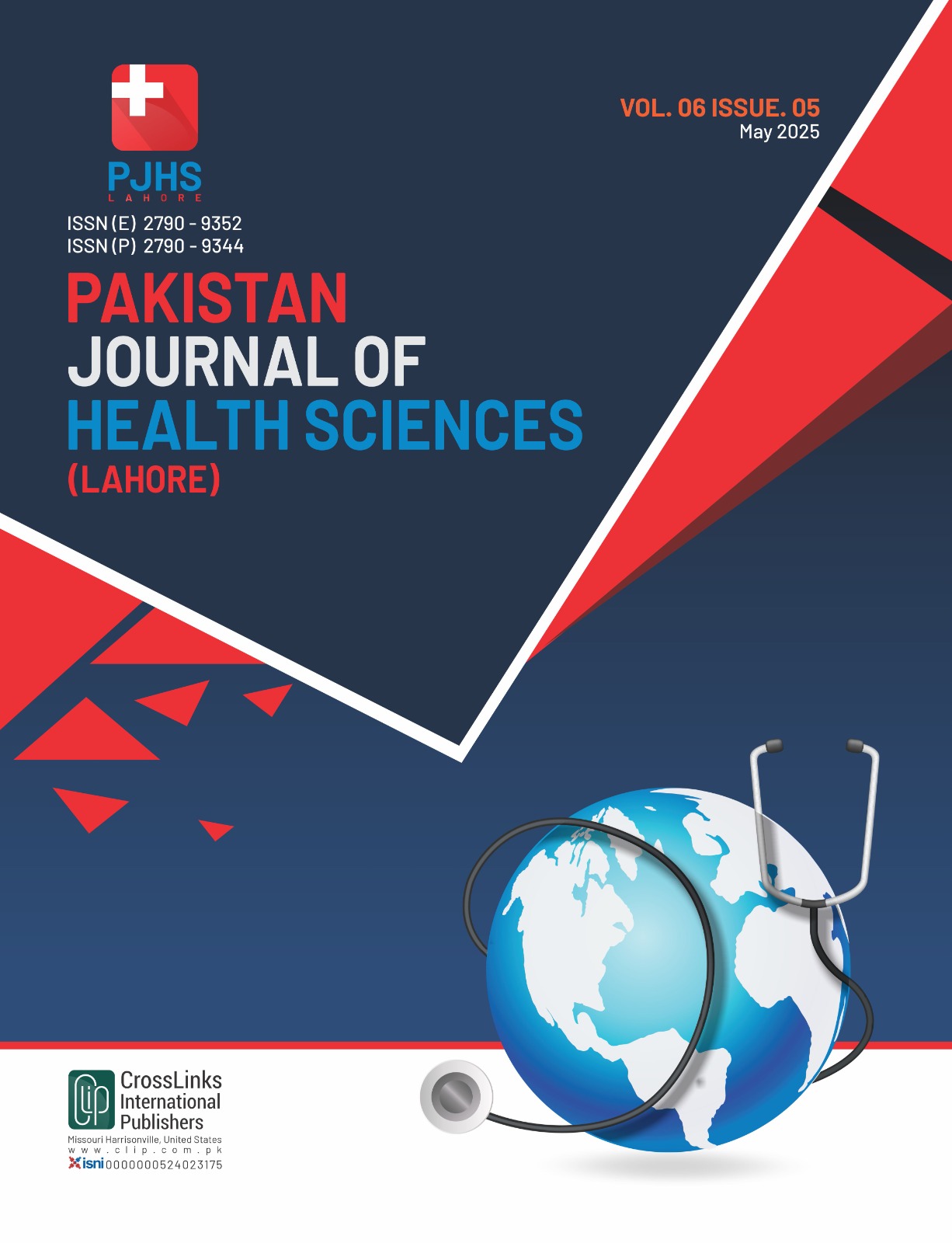Comparison of Micro Needling with Topical Tranexamic Acid and Mesotherapy with Intradermal Tranexamic Acid in Treatment of Melasma
Microneedling versus Mesotherapy in Melasma
DOI:
https://doi.org/10.54393/pjhs.v6i5.2533Keywords:
Melasma, Tranexamic Acid, Microneedling, MesotherapyAbstract
Melasma is a common hyperpigmentation disorder that poses therapeutic challenges due to its recurrent and resistant nature. Microneedling showed superior and faster pigmentation reduction, with significant MASI score improvement and no adverse effects. Objective: To compare the effectiveness of intradermal Tranexamic Acid (TA) via mesotherapy versus topical TA delivered through microneedling in the treatment of melasma. Methods: In this prospective comparative study, 100 patients were divided into two equal groups. Group A received intradermal injections of TA (100 mg/mL), and Group B was treated with the same concentration of TA via microneedling using the Dr. PEN A6 device. Each group received three treatments at two-week intervals. Outcomes were assessed at Weeks 4, 8, 12, 16, and 20 using the Melasma Area and Severity Index (MASI) and standardized clinical photography. Statistical analysis was performed using repeated measures ANOVA, with a significance threshold of p ≤ 0.05. Results: The mean age was 37.7 ± 6.1 years. Group B showed greater improvement in MASI scores compared to Group A, with a 32.5% vs 18.4% reduction at Week 4 (p = 0.17). Group B consistently showed statistically significant improvement at Weeks 12, 16, and 20 (p < 0.05), and a strong trend by Week 8 (p = 0.001). No adverse events were reported. Conclusion: TA is an effective treatment for melasma. Microneedling significantly enhances its efficacy, providing faster and greater pigmentation reduction with minimal side effects.
References
Abdalla MA. Melasma clinical features, diagnosis, epidemiology and etiology: an update review. Siriraj Medical Journal. 2021 Dec; 73(12): 841-50. doi: 10.33192/Smj.2021.109. DOI: https://doi.org/10.33192/Smj.2021.109
Artzi O, Horovitz T, Bar‐Ilan E, Shehadeh W, Koren A, Zusmanovitch L et al. The pathogenesis of melasma and implications for treatment. Journal of Cosmetic Dermatology. 2021 Nov; 20(11): 3432-45. doi: 10.1111/jocd.14382. DOI: https://doi.org/10.1111/jocd.14382
Bertotti PP and Cé R. Melasma: Understanding Its Complexity and Accurate Therapeutic Approaches. Revista Científica Sophia. 2024 Feb; 16(1).
Ali L and Al Niaimi F. Pathogenesis of melasma explained. International Journal of Dermatology. 2025 Feb. doi: 10.1111/ijd.17718. DOI: https://doi.org/10.1111/ijd.17718
Lazar M, De La Garza H, Vashi NA. Exogenous ochronosis: characterizing a rare disorder in skin of color. Journal of Clinical Medicine. 2023 Jun; 12(13): 4341. doi: 10.3390/jcm12134341. DOI: https://doi.org/10.3390/jcm12134341
Maddaleno AS, Camargo J, Mitjans M, Vinardell MP. Melanogenesis and melasma treatment. Cosmetics. 2021 Sep; 8(3): 82. doi: 10.3390/cosmetics8030082. DOI: https://doi.org/10.3390/cosmetics8030082
Liu W, Chen Q, Xia Y. New mechanistic insights of melasma. Clinical, Cosmetic and Investigational Dermatology. 2023 Dec: 429-42. doi: 10.2147/CCID.S396272. DOI: https://doi.org/10.2147/CCID.S396272
Kania B, Lolis M, Goldberg D. Melasma Management: A Comprehensive Review of Treatment Strategies Including BTX‐A. Journal of Cosmetic Dermatology. 2025 Feb; 24(2): e16669. doi: 10.1111/jocd.16669. DOI: https://doi.org/10.1111/jocd.16669
Xu Y, Ma R, Juliandri J, Wang X, Xu B, Wang D et al. Efficacy of functional microarray of microneedles combined with topical tranexamic acid for melasma: A randomized, self-controlled, split-face study. Medicine. 2017 May; 96(19): e6897. doi: 10.1097/MD.0000000000006897. DOI: https://doi.org/10.1097/MD.0000000000006897
Hoque F, McGrath J, Shaude SE. Melasma (Chloasma): pathogenesis and treatment. Journal of Biotechnology and Biomedicine. 2022 Nov; 5(4): 236-43. doi: 10.26502/jbb.2642-91280064. DOI: https://doi.org/10.26502/jbb.2642-91280064
Cassiano DP, Espósito AC, da Silva CN, Lima PB, Dias JA, Hassun K et al. Update on melasma-part II: treatment. Dermatology and Therapy. 2022 Sep; 12(9): 1989-2012. doi: 10.1007/s13555-022-00780-4. DOI: https://doi.org/10.1007/s13555-022-00780-4
Piętowska Z, Nowicka D, Szepietowski JC. Understanding melasma-how can pharmacology and cosmetology procedures and prevention help to achieve optimal treatment results? A narrative review. International Journal of Environmental Research and Public Health. 2022 Sep; 19(19): 12084. doi: 10.3390/ijerph191912084. DOI: https://doi.org/10.3390/ijerph191912084
Ghasemiyeh P, Fazlinejad R, Kiafar MR, Rasekh S, Mokhtarzadegan M, Mohammadi-Samani S. Different therapeutic approaches in melasma: advances and limitations. Frontiers in Pharmacology. 2024 Apr; 15: 1337282. doi; 10.3389/fphar.2024.1337282. DOI: https://doi.org/10.3389/fphar.2024.1337282
Galache TR, Sena MM, Tassinary JA, Pavani C. Photobiomodulation for melasma treatment: integrative review and state of the art. Photodermatology, Photoimmunology & Photomedicine. 2024 Jan; 40(1): e12935. doi: 10.1111/phpp.12935. DOI: https://doi.org/10.1111/phpp.12935
Jo JY, Chae SJ, Ryu HJ. Update on melasma treatments. Annals of Dermatology. 2024 Mar; 36(3): 125. doi: 10.5021/ad.23.133. DOI: https://doi.org/10.5021/ad.23.133
Gao TW, Gu H, He L, Lei TC, Li M, Li TN et al. Pigmentary Disorder Group, Combination of Traditional and Western Medicine Dermatology, Research Center for Vitiligo, Chinese Society of Dermatology, Working Group on Pigmentary Disorders, China, Dermatologist Association Consensus on the diagnosis and treatment of melasma in China (2021 version). International Journal of Dermatology and Venereology. 2021 Sep; 4(03): 133-9. doi: 10.1097/JD9.0000000000000164. DOI: https://doi.org/10.1097/JD9.0000000000000164
Desai SR, Alexis AF, Elbuluk N, Grimes PE, Weiss J, Hamzavi IH et al. Best practices in the treatment of melasma with a focus on patients with skin of color. Journal of the American Academy of Dermatology. 2024 Feb; 90(2): 269-79. doi: 10.1016/j.jaad.2023.07.1045. DOI: https://doi.org/10.1016/j.jaad.2023.07.1045
Bostan E and Cakir A. The dermoscopic characteristics of melasma in relation to different skin phototypes, distribution patterns and wood lamp findings: a cross-sectional study of 236 melasma lesions. Archives of Dermatological Research. 2023 Sep; 315(7): 1927-38. doi: 10.1007/s00403-023-02584-8. DOI: https://doi.org/10.1007/s00403-023-02584-8
Li Yun, Liu Jie, Sun Qiuning. Dermoscopic features of melasma. Zhongguo Yixue Kexueyuan Xuebao (Acta Academiae Medicinae Sinicae). 2015 May; 37(2): 226–9.
Winaya KK, Mahariski PA, Praharsini IG, Pramita IG. Dermoscopic features of melasma: a descriptive study in Bali. Bali Medical Journal. 2023 Oct; 12(3): 3042-4. doi: 10.15562/bmj.v12i3.4839. DOI: https://doi.org/10.15562/bmj.v12i3.4839
Downloads
Published
How to Cite
Issue
Section
License
Copyright (c) 2025 Pakistan Journal of Health Sciences

This work is licensed under a Creative Commons Attribution 4.0 International License.
This is an open-access journal and all the published articles / items are distributed under the terms of the Creative Commons Attribution License, which permits unrestricted use, distribution, and reproduction in any medium, provided the original author and source are credited. For comments













